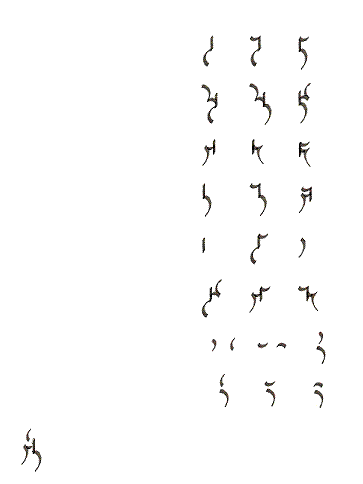User:Masako/sandbox: Difference between revisions
From FrathWiki
Jump to navigationJump to search
mNo edit summary |
mNo edit summary |
||
| Line 63: | Line 63: | ||
|- | |- | ||
|} | |} | ||
=== y === | |||
[[Image:Kito nm.GIF]] | |||
'''Kito''' is an abugida, or syllabic alphabet, used to represent the '''Kala''' language. | |||
=== notable features === | |||
*'''Kito''' is written in glyph blocks by vertically stacking the syllable glyphs to form words. The script is written vertically, in columns running from left to right. | |||
*The word '''kito''' not only refers to the script but also means "mark, symbol, glyph" in '''Kala'''. | |||
*'''Kito''' was inspired by [[Wikipedia:Phagspa_script|Phags-pa]], and the [[Wikipedia:Seal_script|Chinese Seal Script]]. | |||
*'''Kito''' contains 14 syllable glyphs, 4 cluster glyphs, and 7 vowel diacritics. | |||
=== consonants === | |||
[[Image:Kito cons.GIF]] | |||
=== cluster glyphs === | |||
[[Image:Kito clusters.GIF]] | |||
=== vowel diacritics === | |||
[[Image:Kito vwl.GIF]] | |||
=== notes === | |||
*The vowels are placed below the syllable they modify. | |||
*The labialisation and palatalization are shown by modifying the vowel diacritics as shown above. | |||
*The script can also be written horizontally in glyph blocks, but this is only done to save space. | |||
Revision as of 10:03, 3 May 2009
| Subject \ Object | 1SG | 2SG | 3SG | 1PL | 2PL | 3PL |
| 1SG | na'i | na'eta | na'eha | X | na'etam | na'ekam |
| 2SG | ta'ena | ta'i | ta'eha | ta'enam | X | ta'ekam |
| 3SG | ha'ena | ha'eta | ha'i | ha'enam | ha'etam | ha'ekam |
| 1PL | X | nameta | nameha | nami | nametam | namekam |
| 2PL | tamena | X | tameha | tamenam | tami | tamekam |
| 3PL | kamena | kameta | kameha | kamenam | kametam | kami |
| 1st sing | 2nd sing | 3rd sing | 1st plu | 2nd plu | 3rd plu | |
|---|---|---|---|---|---|---|
| 1st sing | na'eta | na'eha | na'etam | na'ekam | ||
| 2nd sing | ta'ena | ta'eha | ta'enam | ta'ekam | ||
| 3rd sing | ha'ena | ha'eta | ha'enam | ha'etam | ha'ekam | |
| 1st plu | nameta | nameha | nametam | namekam | ||
| 2nd plu | tamena | tameha | tamenam | tamekam | ||
| 3rd plu | kamena | kameta | kameha | kamenam | kametam |
y
Kito is an abugida, or syllabic alphabet, used to represent the Kala language.
notable features
- Kito is written in glyph blocks by vertically stacking the syllable glyphs to form words. The script is written vertically, in columns running from left to right.
- The word kito not only refers to the script but also means "mark, symbol, glyph" in Kala.
- Kito was inspired by Phags-pa, and the Chinese Seal Script.
- Kito contains 14 syllable glyphs, 4 cluster glyphs, and 7 vowel diacritics.
consonants
cluster glyphs
vowel diacritics
notes
- The vowels are placed below the syllable they modify.
- The labialisation and palatalization are shown by modifying the vowel diacritics as shown above.
- The script can also be written horizontally in glyph blocks, but this is only done to save space.
